Starlings are medium-sized passerines, that often have dark plumage with a beautiful metallic sheen.

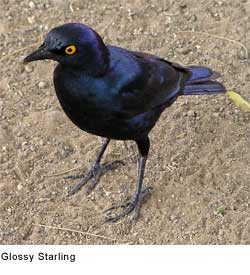 Just the Facts: Starling flight is strong and direct, and they are very gregarious. Their preferred habitat is fairly open country, and they eat insects and fruit. Several species live around habitation, and are effectively omnivores. Just the Facts: Starling flight is strong and direct, and they are very gregarious. Their preferred habitat is fairly open country, and they eat insects and fruit. Several species live around habitation, and are effectively omnivores.
Many species search for food by opening the bill after probing it into dense vegetation; this behavior is called "open-bill probing" or is referred to by the German word "zirkeln."
Starling, aka... Many Asian
species, particularly the larger ones, are called mynas, and the
members of the African genus Lamprotornis are known as glossy starlings because of their iridescent plumage. The two species of Buphagus are called oxpeckers.
Chatty Kathies: Starlings have diverse and complex vocalizations, and have been known to imbed sounds from their surroundings into their own calls, including car alarms, and human speech patterns. The birds can recognize particular individuals
by their calls, and are currently the subject of research into the evolution of
human language.
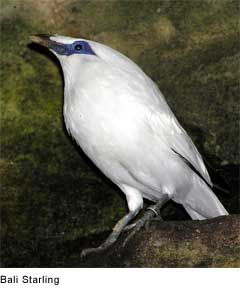 Starling Strut: Starlings walk rather than hop. Their flight is quite strong and direct; they look triangular-winged Starling Strut: Starlings walk rather than hop. Their flight is quite strong and direct; they look triangular-winged
and short-tailed in flight. In most
of Europe, only the rarer and much paler Bohemian Waxwing shares
this flight profile.
This is a noisy bird uttering a wide variety of mechanical-sounding and melodic sounds, including a distinctive "wolf whistle." Starlings are also noted as mimics, like many of its family. In captivity, Starlings will learn to imitate all types of sounds and speech earning them the nickname "Poor-man's Myna".
Starling Invadors: Common Starlings introduced to North America have been a factor in reducing native cavity nesting bird populations (such as Bluebirds and Red-headed Woodpeckers) by competing aggressively for nesting cavities.
The "Black Sun" Phenomenon: During spring in Denmark, at approximately half an hour before sunset, flocks of more than a million European starlings gather from all corners to join in incredible formations. This phenomenon is called Black Sun and can be witnessed in early spring throughout the marshlands of western Denmark, from March through to the middle of April. The starlings migrate from the south and spend the day in the meadows gathering food, sleeping in the reeds during the night. The best place to view this amazing aerial dance is in the place called Tøndermarsken.
Hole in the Wall: Most species nest in holes, laying blue or white eggs.
-----------------------------------------------------------------------------------------------------------------------------
European Starling: The European Starling or Common Starling, Sturnus vulgaris, is a passerine bird in the family Sturnidae. This starling is native to most of Eurasia, but has been introduced to South Africa, North America, Australia and New Zealand. It is resident in southern and western Europe, but northern and eastern populations migrate in winter to these regions, and also further south to areas where it does not breed in Iberia and north Africa. European Starlings will eat almost anything, including farmland invertebrates and berries, and garbage.
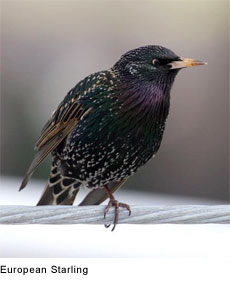 Startling Starling:
This is a highly gregarious species, forming huge flocks in winter, and providing a spectacular sight and sound as they descend into evening reed-bed roosts, often attracting birds of prey such as Merlins or Sparrowhawks. Startling Starling:
This is a highly gregarious species, forming huge flocks in winter, and providing a spectacular sight and sound as they descend into evening reed-bed roosts, often attracting birds of prey such as Merlins or Sparrowhawks.
Large roosts (exceptionally up to a million birds) can form in city centers, causing a great deal of mess from their droppings. Flocks are also noted for forming a tight sphere-like formation in flight, then expanding and contracting and even changing shape, all seemingly without any sort of leader.
Feathered and Familiar: The 19-22 cm long European Starling must be one of the most familiar of birds in temperate regions, with its shiny black plumage spangled with white. Confusion is only likely in Iberia in winter, when it has to be distinguished from the closely related Spotless Starling, which, as its name implies, has less spotting on its plumage. Adult male European Starlings are less spotted below than adult females. Juveniles are dull brown, and by their first winter resemble adults but are browner especially on the head.
Struggling Songsters: The European Starling has been adversely affected by intensive agriculture, and in countries like the UK it has been red-listed since its numbers are falling, although it remains a widespread and very common species.
Starling Subspecies: There are two subspecies of the European Starling. The Shetland Starling, S. vulgaris subsp. zetlandicus is slightly larger than the nominate S. vulgaris subsp. vulgaris, and is found in Shetland, Fair Isle and the Western Isles.The Faroese Starling, S. vulgaris subsp. faroeensis is the largest (European) variant of the starling. The winter adult is black with blue shades, which become green in the summer. This subspecies is only found in the Faroe Islands.
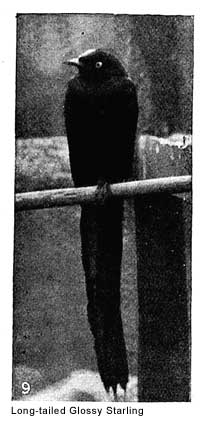 Scottish Stars on the Rise: Originally the Starlings of Scotland and England were similar to those of the European mainland, but they died out in Scotland before 1800 and became rare in England. A hundred years later, around 1900, S. vulgaris subsp. vulgaris, recolonised from Europe, and since about 1940 this subspecies has spread to Iceland, where there are today thriving colonies in both East and West Iceland. S. vulgaris subsp. vulgaris is occasionally seen in the Faroes too. Scottish Stars on the Rise: Originally the Starlings of Scotland and England were similar to those of the European mainland, but they died out in Scotland before 1800 and became rare in England. A hundred years later, around 1900, S. vulgaris subsp. vulgaris, recolonised from Europe, and since about 1940 this subspecies has spread to Iceland, where there are today thriving colonies in both East and West Iceland. S. vulgaris subsp. vulgaris is occasionally seen in the Faroes too.
Introduced Populations: This adaptable and omnivorous species is considered to be a pest in several of the countries to which it has been introduced. The European Starling is a hole-nesting species and will nest in just about any cavity it finds. It has impacted on native species where it has been introduced because of competition for nest sites.
Bounty Hunters: In Western Australia, which is Starling-free, the government pays full-time hunters to patrol the border and shoot Starlings as they arrive.
Foreign Newcomers: Although there are approximately 200 million starlings in
North America, they are all descendants of approximately 60 birds released in Central Park, New York, by Eugene Schieffelin, who headed an acclimatization society
trying to introduce to North America every bird species mentioned in the works of William Shakespeare.
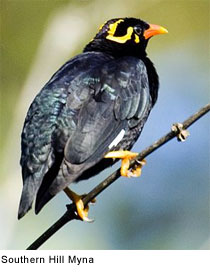 Bully Birds: The descendents of these Starlings have created mayhem in North America. Many species are losing nesting sites to the more aggressive Starlings. Starlings will also sometimes drive off native birds, including the bluebirds (Sialia spp.), the Purple Martin (Progne subis), Tree Swallows (Iridoprocne bicolor), and some Bully Birds: The descendents of these Starlings have created mayhem in North America. Many species are losing nesting sites to the more aggressive Starlings. Starlings will also sometimes drive off native birds, including the bluebirds (Sialia spp.), the Purple Martin (Progne subis), Tree Swallows (Iridoprocne bicolor), and some
of the smaller species of woodpecker.
They have even been observed taking over the nests of House Sparrows, another introduced species.
A century after their introduction they have contributed to the decline of all of the above, multiplying rapidly, and can now be found throughout North America and Alaska to the point of overpopulation.
These birds pose enough of a threat to songbirds that it is legal to kill Starlings at any time in the U.S. and Canada, and a bounty may be paid. It is also a common practice where possible to set up nest boxes in backyards and wooded areas for native species to give them a chance, and to destroy Starling nests.
All text is available under the terms
of the GNU Free Documentation License
|